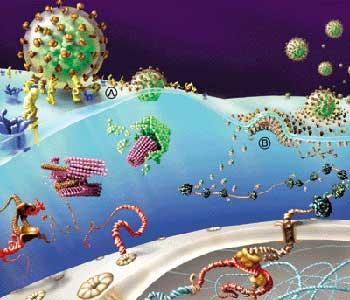Threat beast txikia
2001/12/01 Agirre Ruiz de Arkaute, Aitziber - Elhuyar Zientzia Iturria: Elhuyar aldizkaria

Threat beast txikia

AIDS came from America. Five apparently healthy homosexuals appeared affected by pneumonia and other homosexuals developed rare diseases. On the other hand, other men who used drugs were in a similar situation. Behind all these different diseases appears a common factor: the immune system of all patients was weakened. From there, the disease that spread through sexual secretions and blood spread all over the world to heterosexuals, women... all human groups.
They immediately began to try to unravel the origin of the virus that caused that rare disease. According to the initial hypotheses, homosexual American tourists who emigrated to the Congo in the 1970s became infected and developed the disease. Apparently, the virus was established in equatorial Africa, but with its population lived in peace, they did not develop the disease. But as a result of the movement of travelers of recent decades, the virus came into contact with people who lacked the blood characteristics of the natives and these, more sensitive to the virus infection, developed the disease.
The truth is that it wouldn't be the first time that happens. The pathogens carried by the Spanish conquerors also contaminated and diseased thousands of Native Americans five centuries ago. In many places, viruses causing smallpox and flu caused the death of 80% of the population. According to this first hypothesis, something similar could occur in the case of AIDS.
However, more recent hypotheses have given a very different explanation. According to researcher Edward Hooper, Human Immunodeficiency Virus (HIV) reached humans with the Polio virus vaccine. The polio vaccine was developed at the Wistar Institute in Philadelphia in the 1950s, using cultures of chimpanzee kidney cells. Between 1957 and 1959, the polio vaccine was tested in the Congo with a million human beings and AIDS spread to the four winds.

According to Hooper, these kidney cells were infected with the Monkeys Immunodeficiency Virus and by testing the vaccine with humans, the virus was able to infect its new host and caused death. Other researchers, however, have wanted to despise the Hooper hypothesis, since, according to them, these chimpanzee cells were used in Congo itself to obtain more samples of vaccine from Philadelphia. However, it can hardly be understood that in the 1950s such techniques can be used in the Congo.
Although the origin of the virus has not yet been revealed, it seems that it was in the Congo where the greatest diversity of the virus appears for the first time. Only in the Congo there is a greater diversity than in all other countries at once. This diversity can only be due to a long mutation process, so it can be concluded that the virus takes longer in Congo than anywhere else.
In fact, HIV, in a single infected individual, can produce a larger genomic variety than in the entire epidemic. It is therefore difficult to realize the diversity that can exist in millions of people affected by HIV. The development of a vaccine against such a versatile virus has a great difficulty, since, if one is not the other, the body caregiver will avoid it.
The case of AIDS has been very special within science; suddenly, thousands of scientists got to work on this issue. Thus, in 1981 they knew the first case of the disease and identified it before two years. By 1985 the pathways of transmission of the virus were known and by 1986 clinical trials were being conducted with the first antiviral drugs.
However, the variability of the virus has greatly hindered the work of scientists. This year has been 20 years since the first AIDS case was released and the vaccine is yet to be obtained. But the results of these studies have taught much about the life of this little beast.
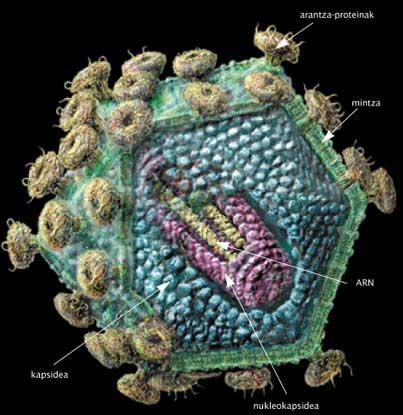
Giant Txiki
It is not easy to understand that a small particle of this type can endanger the human body. Animals have developed complex protection systems, but viruses are capable of causing serious diseases in humans.
It is known that viruses are very special, to the point of questioning whether they are alive, because unlike other living beings, viruses do not have cellular organization. Cells are the basis of all living beings, there is all the necessary machinery to read genetic information and produce proteins. Viruses, however, are very simple, have genetic information but, if not, little. Human immunodeficiency virus, for example, has only 9 genes and human cells more than 40,000 genes.
This is why it does not have a cellular structure, since with so few genes it does not have enough information to create the machinery of the cell and must use that of the cell that infects it. Viruses have developed a reproductive strategy by accessing the cell. They must colonize the cells: access the inside and control their machinery. From that moment on, the cell will be available to the virus and use it to reproduce and create more viruses. Thus, the virus will get what it wanted: disperse thousands of viral particles through the body.
Although HIV contains only nine genes, it has developed everything necessary to introduce and control it. On the one hand, it has created a kind of case –nucleocapside– that protects its genes, the capsicum above and the flexible membrane around it. The cells also have this type of membrane, which will help the virus enter them. Both membranes can bind together, like the two drops of oil in the water, and the virus canpside will appear inside the cell.

In addition, the virus contains spiny proteins in this membrane. These are like a key: they can only be inserted into cells with the corresponding lock. That is why they do not infect any type of cell.
HIV Strategy
It can be said that the human body is like a castle. Like these, it has a very developed protection system: the immune system. When a particle or a living stranger enters, those who care for the body face each other.
In general, viruses and other specific microbes, organs or tissues of the body (liver, intestine, etc.) are infected and body guards can then know and destroy the pathogen. However, the strategy developed by HIV is very different: instead of infecting these organs, it attacks and infects guards. In this way, he will leave the body unattended, will not be able to destroy the virus and man will be defenseless against other pathogens. In this situation, pathogens will quietly enter the body without fear of the few remaining vulnerable guardians.
To destroy the guardian, in this case T lymphocytes, HIV has the key that knows its lock (molecule CD4), so you can access the inside of the vigilante. Once the pattern is colonized, it will program its machinery to produce virus proteins. The virus will use the cell to reproduce and then destroy more caregivers. In this way, as the lymphocytes become infected, the castle becomes unguarded and therefore unprotected.
A unique opportunity for parasites around
This unprotected situation will open the doors to other microorganisms. Unlike others, on this occasion they will circulate with the certainty that no one will destroy them and they will have a great opportunity to succeed in the infection. Therefore, about 100 opportunistic infections from viruses, bacteria, fungi and protozoa have been linked to AIDS. Meningitis, Kaposi sarcoma, pneumonia, toxoplasmosis, tuberculosis, candidiasis and herpes are the most common diseases.
The truth is that attenuated vaccines that have been created to protect themselves from poliovirus and measles also become dangerous pathogens for those people with weakened immune systems. In short, to protect yourself from your infection, the immune response that affects HIV is necessary. That is why 1.5 million children in Africa suffer from AIDS and HIV also endangers polio eradication, as they cannot receive a vaccine. In this way, experts point out that people with AIDS are depositing many diseases.
In this situation, microbes that cannot infect humans have 37 million people with weakened immune systems waiting for them to become infected and become human pathogens. First they will adapt to those affected by immunodeficiency and then they will become infected to those who have a healthy immune system. For many animal microbes, this large group of sensitive people can be an excellent opportunity to become human pathogens.
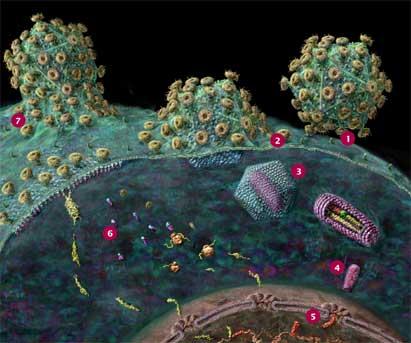
By knowing the spiny proteins of HIV the cell's CD4 receptor (1), the virus discovers that it has found the right cell. At that time the membranes of the virus and the cell (2) will converge and the capsicum of the former will appear in the cell cytoplasm (3). By dissolving the capside, it will release the genetic material that houses the nucleoapside (4). Reverse transcriptase from this RNA will generate DNA that will be integrated into the cell genome (5) for the cell to express as its own. It will then form the virus proteins and replicate the genetic information. All components that form the virus will be rejoined (6) and removed with a cell membrane fraction (7). New viruses are ready to infect more cells!
When the cell is positioned in favor of the virus
When colonizing the cell, the first objective of the Human Immunodeficiency Virus is to reproduce so that hundreds of viruses enter a virus. To do this, you first have to copy your genetic information so that each of the viruses that are to be produced later keeps the information necessary to get ahead. A particle without genetic information has no future. Therefore, this first virus will aim to obtain genetic information for all viruses.
But to begin with, you must express that genetic information, that is, form proteins with the information written in it. These proteins will help you control the cell. The strategy developed by viruses is simple but at the same time effective, as they are able to control the entire cell with a few proteins.
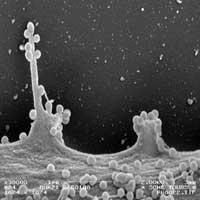
With this intention, the virus will integrate its genetic information into the cell's genome, so that it enters and expresses it as its own. To do this, the virus must transform its genetic information. All living beings with cellular organization, from bacteria to humans, organize genetic information as DNA. From the information contained in DNA they create RNA and thereby proteins. However, viruses can store information in many ways.
The virus that causes AIDS keeps it in the form of RNA, but if you want to multiply it, you will have to adapt your genetic information to the one that stores the cell. To do this, the virus must first convert the RNA into DNA, which is the same as the cell, so that it enters the manure, which is the function of the reverse transcriptase enzyme. Blocking this enzyme prevents the virus from integrating its genetic information into cell information, so the virus cycle will not be able to continue and the infection will cease.
But the cell will not only provide machinery for the formation and reproduction of proteins, but will also provide energy and raw materials. This will allow you to live the virus. The cell, however, is affected by the constant proliferation of the virus. From infection, one billion viral particles are formed every day.
Virus infections cannot be treated with antibiotics, they do not help to kill the virus. But keeping genetic information in such a strange way forces the virus to have special enzymes. They are enzymes that do not appear spontaneously in cells and can be inhibited without fear of causing damage to the cell. That is why he starts developing therapies and vaccines to treat the infection.
Discovery of Human Immunodeficiency Virus: surprise or theft?
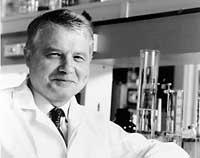
AIDS immediately sparked controversy; at first it appeared a little homophobic, as it seemed that it only infected homosexuals. But the discovery of the virus that caused the disease was equally controversial. Tensions between Frenchman Luc Montagnier and American Robert Gallo were heard all over the world because both claimed they identified that killer virus. In this situation, everyone named him, as they both wanted the honor and hope of winning the Nobel Prize. Finally, then-French Prime Minister Jacques Chirac and U.S. President Ronald Reagan agreed to share the benefits gained from the sale of AIDS diagnostic tests.
But when it was shown that both researchers identified the same virus, more than one accused the American of using the Montagnier virus. In fact, when Montagnier reported the discovery of the virus, as usual among scientists, he sent a sample to Gallo. Within a few months, the U.S. declared isolating the real AIDS virus, which was the cause of AIDS and not the one identified by Montagnier.

In the end, Gallo had to explain in the journal Nature that the virus isolated from his laboratory had been isolated by the virus that Montagnier had previously sent by unintentionally infecting cell cultures. In the end he had to renounce being a discoverer of the virus, but there is still much doubt that Gallo would not have been ‘intentionally’ contaminated by the cultivation of the laboratory.

Gai honi buruzko eduki gehiago
Elhuyarrek garatutako teknologia






